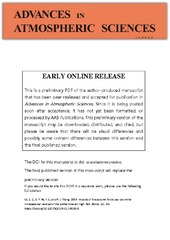| dc.contributor.author | Lü, Zhuozhuo | |
| dc.contributor.author | He, Shengping | |
| dc.contributor.author | Li, Fei | |
| dc.contributor.author | Wang, Huijun | |
| dc.date.accessioned | 2019-07-31T11:48:07Z | |
| dc.date.available | 2019-07-31T11:48:07Z | |
| dc.date.issued | 2019-02 | |
| dc.Published | Lü, He S, Li F, Wang H. Impacts of the autumn Arctic sea ice on the intraseasonal reversal of the winter Siberian high. Advances in Atmospheric Sciences. 2019;36:173-188 | eng |
| dc.identifier.issn | 1861-9533 | en_US |
| dc.identifier.issn | 0256-1530 | en_US |
| dc.identifier.uri | https://hdl.handle.net/1956/20610 | |
| dc.description.abstract | During 1979–2015, the intensity of the Siberian high (SH) in November and December–January (DJ) is frequently shown to have an out-of-phase relationship, which is accompanied by opposite surface air temperature and circulation anomalies. Further analyses indicate that the autumn Arctic sea ice is important for the phase reversal of the SH. There is a significantly positive (negative) correlation between the November (DJ) SH and the September sea ice area (SIA) anomalies. It is suggested that the reduction of autumn SIA induces anomalous upward surface turbulent heat flux (SHF), which can persist into November, especially over the Barents Sea. Consequently, the enhanced eddy energy and wave activity flux are transported to mid and high latitudes. This will then benefit the development of the storm track in northeastern Europe. Conversely, when downward SHF anomalies prevail in DJ, the decreased heat flux and suppressed eddy energy hinder the growth of the storm track during DJ over the Barents Sea and Europe. Through the eddy–mean flow interaction, the strengthened (weakened) storm track activities induce decreased (increased) Ural blockings and accelerated (decelerated) westerlies, which makes the cold air from the Arctic inhibited (transported) over the Siberian area. Therefore, a weaker (stronger) SH in November (DJ) occurs downstream. Moreover, anomalously large snowfall may intensify the SH in DJ rather than in November. The ensemble-mean results from the CMIP5 historical simulations further confirm these connections. The different responses to Arctic sea ice anomalies in early and middle winter set this study apart from earlier ones. | en_US |
| dc.language.iso | eng | eng |
| dc.publisher | Springer | en_US |
| dc.title | Impacts of the autumn Arctic sea ice on the intraseasonal reversal of the winter Siberian high | en_US |
| dc.type | Peer reviewed | |
| dc.type | Journal article | |
| dc.date.updated | 2019-02-06T13:58:10Z | |
| dc.description.version | acceptedVersion | en_US |
| dc.rights.holder | Copyright Institute of Atmospheric Physics/Chinese Academy of Sciences, and Science Press and Springer-Verlag GmbH Germany, part of Springer Nature 2019 | en_US |
| dc.identifier.doi | https://doi.org/10.1007/s00376-017-8089-8 | |
| dc.identifier.cristin | 1652112 | |
| dc.source.journal | Advances in Atmospheric Sciences | |
| dc.source.pagenumber | 173-188 | |
| dc.relation.project | Norges forskningsråd: 244166 | |
| dc.relation.project | NILU - Norsk institutt for luftforskning: 115089 | |
| dc.identifier.citation | Advances in Atmospheric Sciences. 2019;36:173-188 | |
| dc.source.volume | 36 | |
